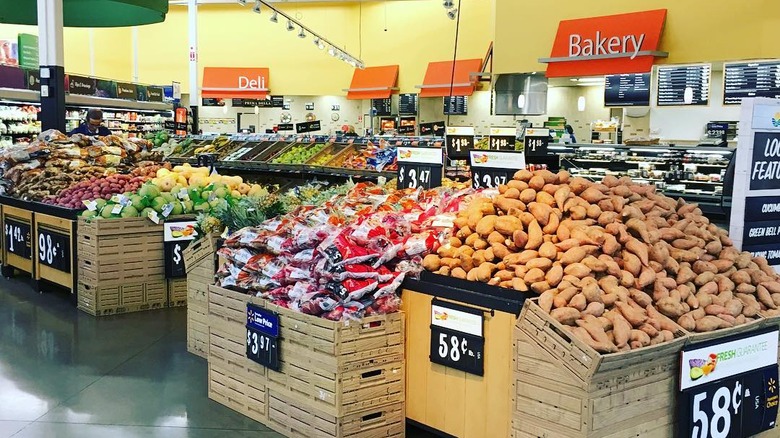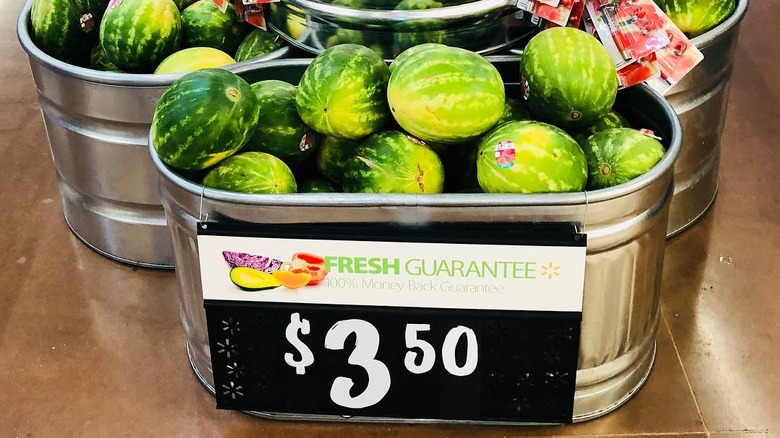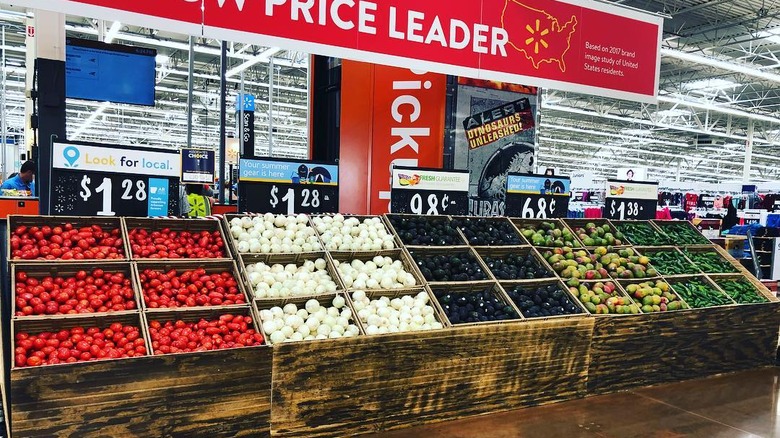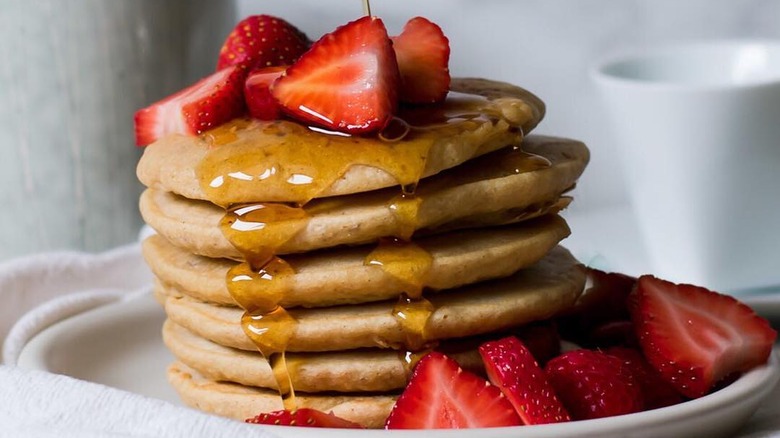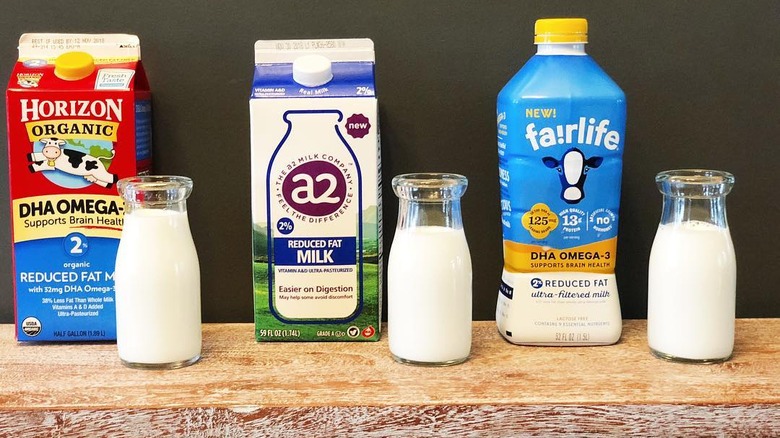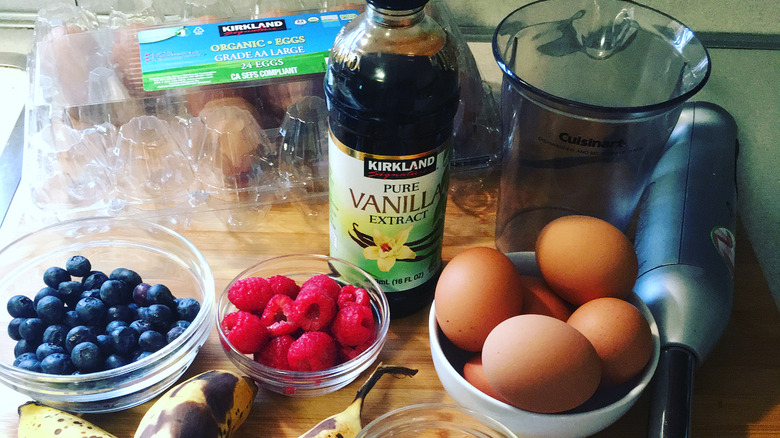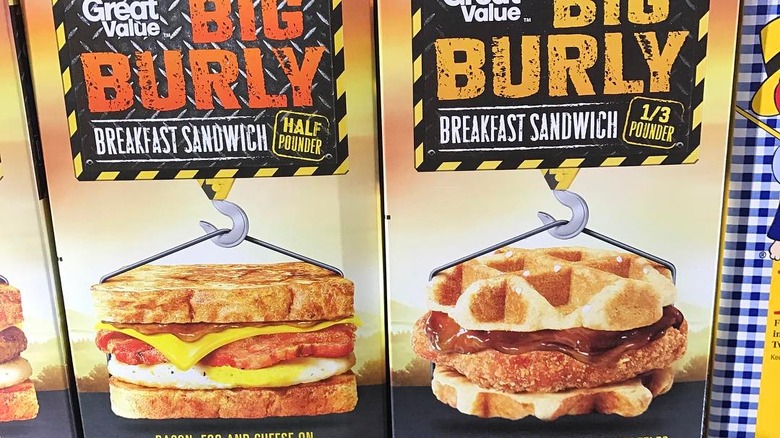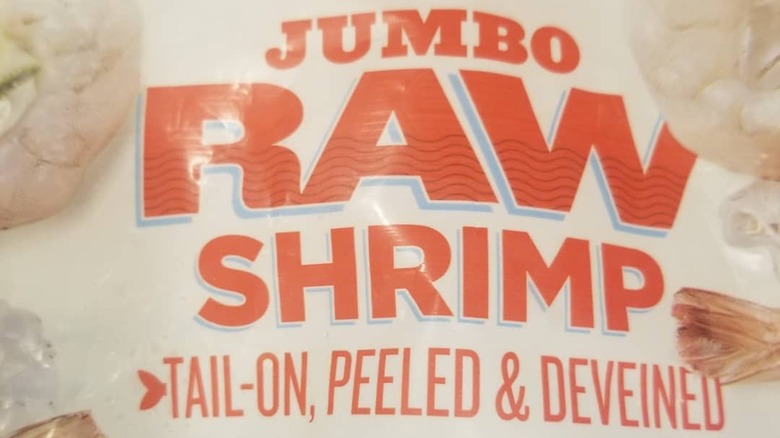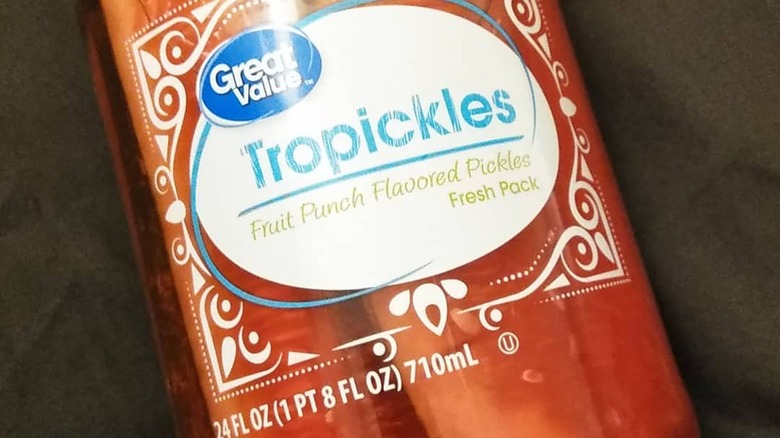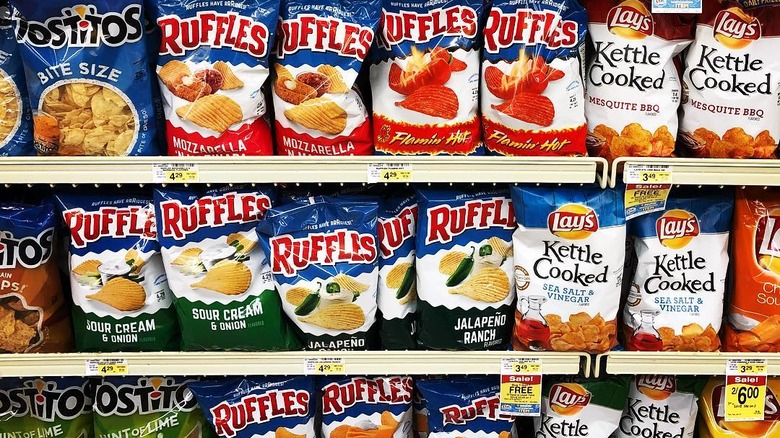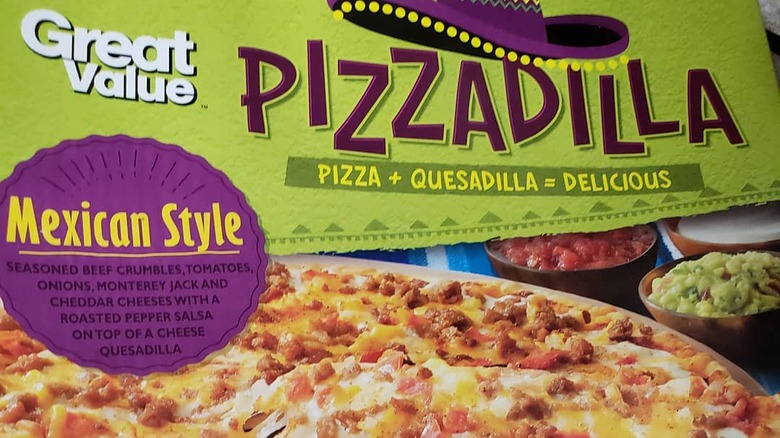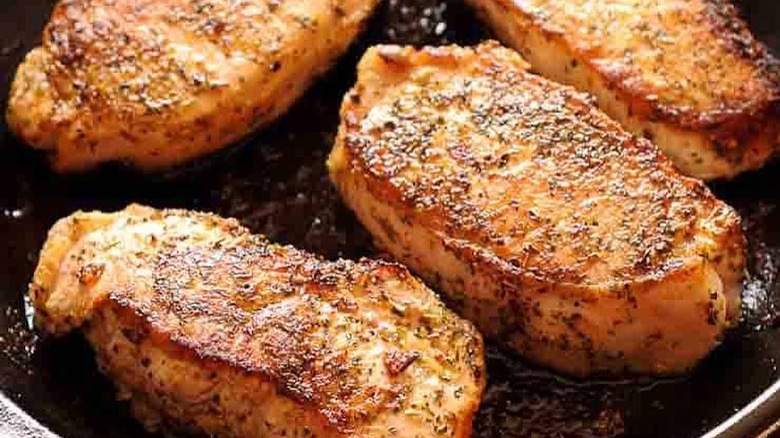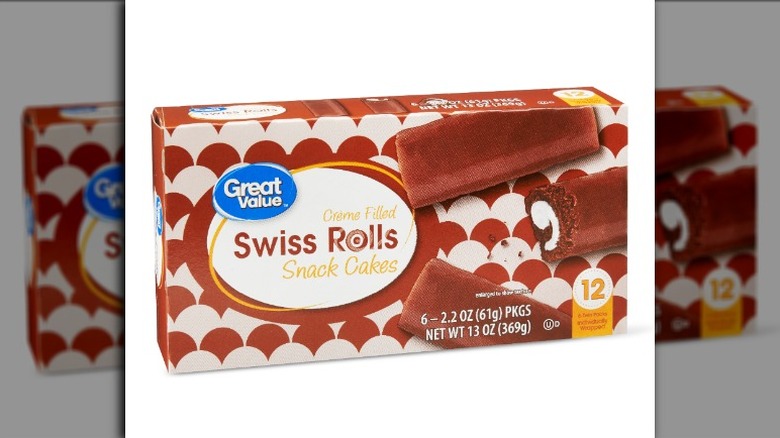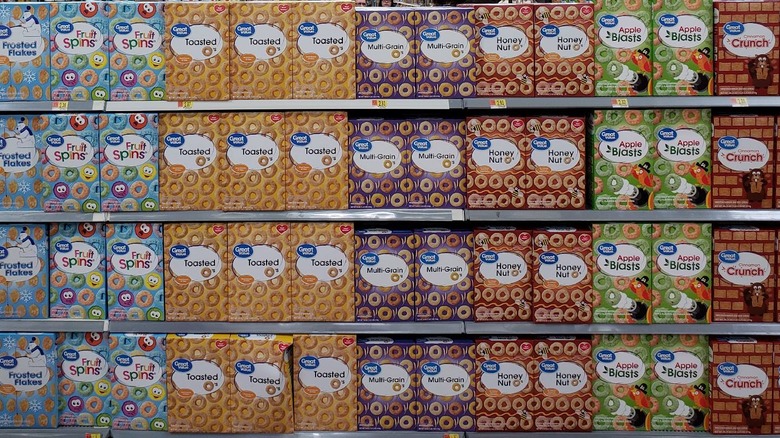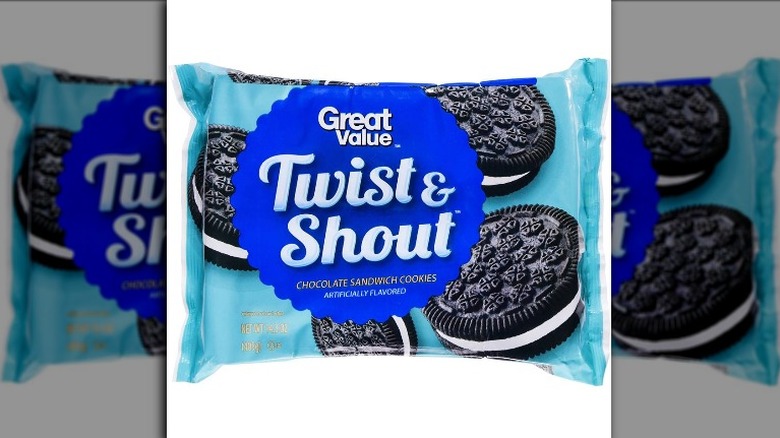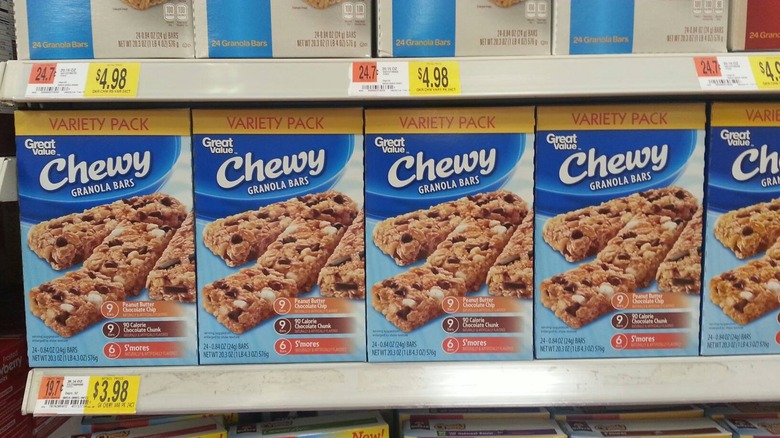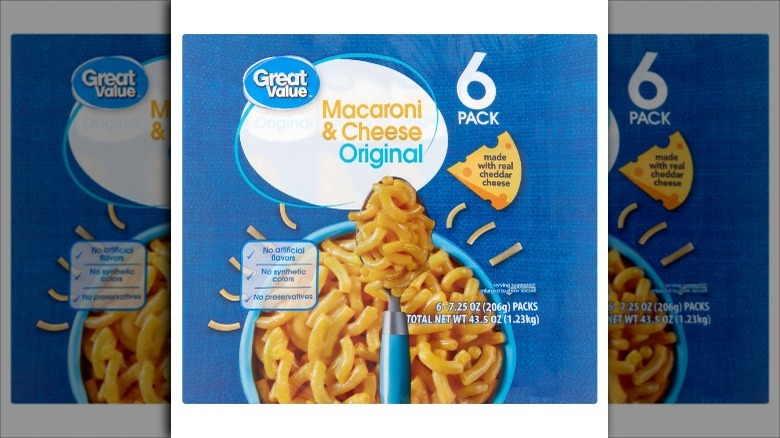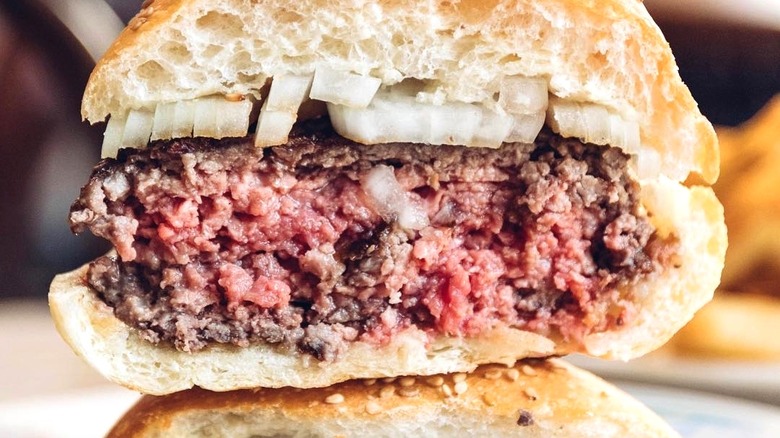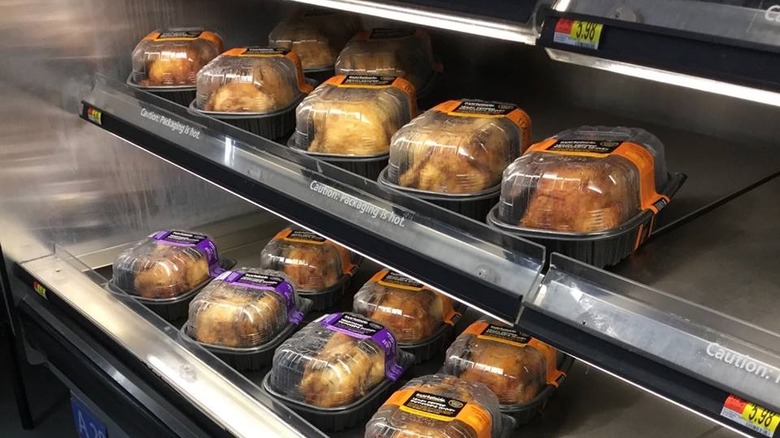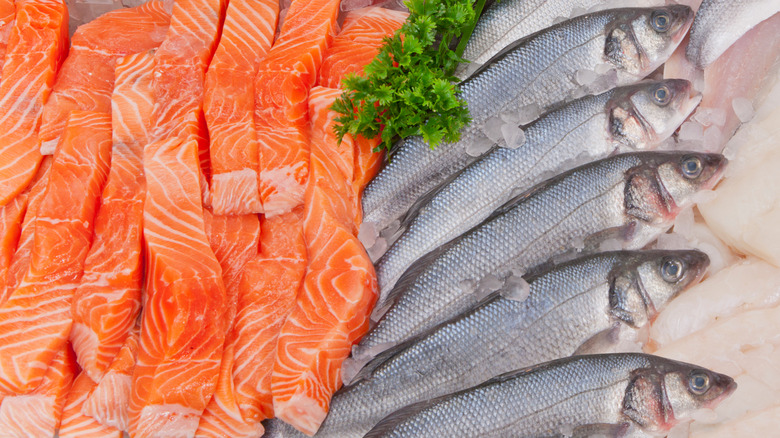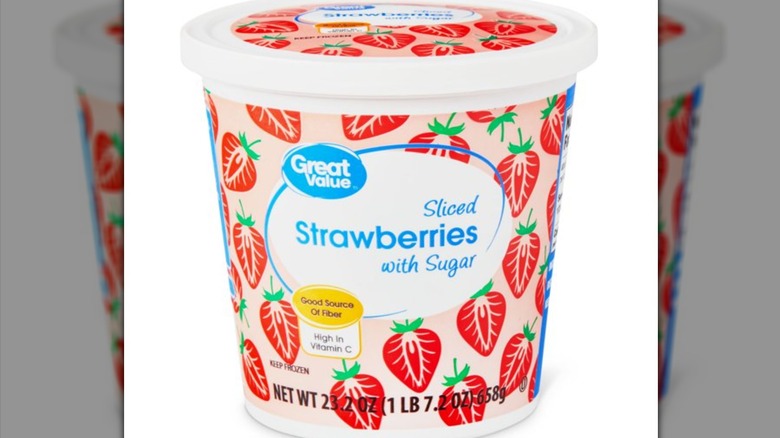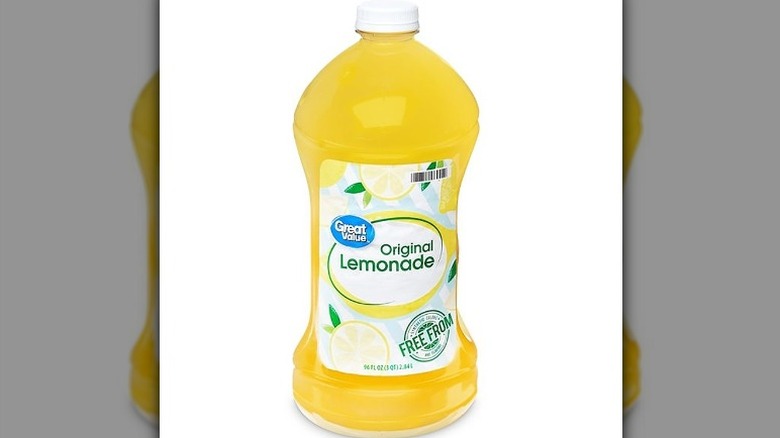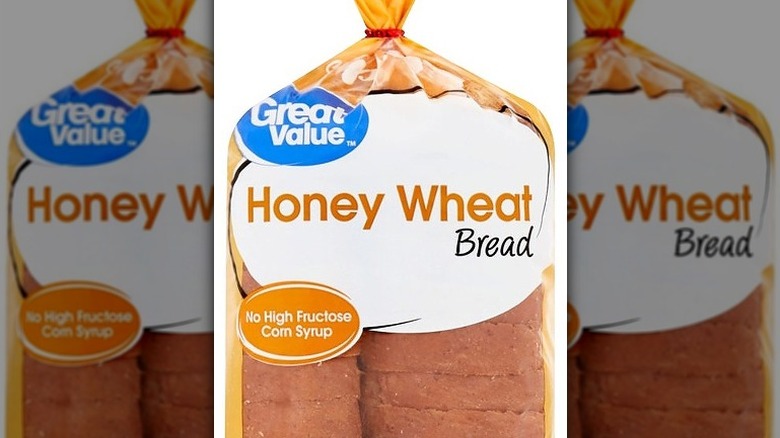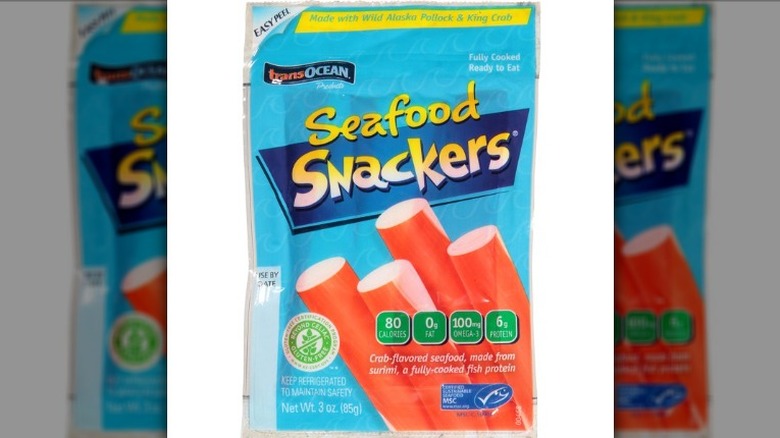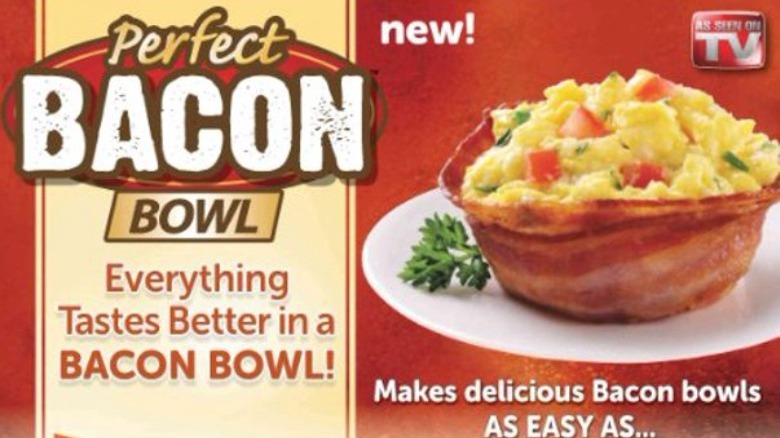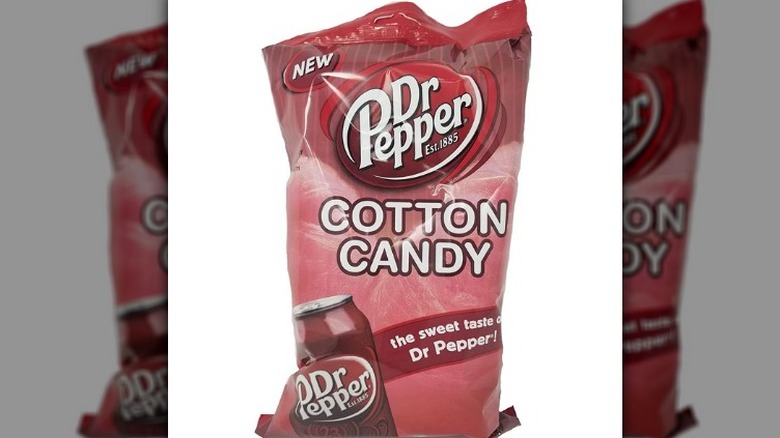25 Foods You Should Never Buy At Walmart
With the introduction of the first Walmart Supercenter way back in 1988, those giant superstores that sell groceries in addition to everything else on the planet, Walmart forever changed the way Americans buy food. In just 30 years, Americans transitioned from visiting produce and farm stands, independent retailers, or even the supermarket for their grocery needs, to shopping for food at Walmart. In fact, grocery sales now account for over half of Walmart's total annual sales, totaling $200 billion each year (via The Washington Post). Factor in sales from Sam's Club, Walmart's warehouse club sister store, and that makes the company the largest retailer of groceries in the country, according to Business Insider.
While the low rollback prices and product exclusives sometimes make it tempting to get your Swiffer refills, picture hanging kits, pressboard furniture, tube socks, printer cartridges, paper towels, firearms, and fresh cantaloupe all in one place, not every item that lines the grocery section of your local Walmart is worth the trip. Here, we take a closer look at the 12 foods you should never buy at Walmart.
1. Organic produce
Sales of organic products drove more than $40 billion dollars in sales in 2015 in the grocery shopping industry, according to the Organic Trade Association. Never content to let $40 billion sit on the table, Forbes reports that Walmart has been capitalizing on this trend, increasing the availability of organic (and sometimes even locally grown) produce in their Supercenters.
Assuming you're one of those people who buys organic products because you don't like eating pesticides, antibiotics, and synthetic hormones, and not because it gives you a thrill to pay $4 dollars for an onion, you're probably always on the hunt for inexpensive organic produce. According to Kiplinger, however, you're unlikely to find those savings at Walmart. In fact, Kiplinger found that rival stores Aldi and Trader Joe's consistently beat Walmart's prices on organic fruits and vegetables. That means that until Walmart begins aggressively rolling back prices on celery and carrots at the same rate as everything else in the store, you're better off buying organic somewhere else.
2. All produce
When it comes to buying fresh fruits and vegetables, sometimes just because you can, doesn't mean you should. Sure, it may be convenient to lump your grocery shopping in with all the other stuff you have to buy every weekend, but the produce at Walmart is generally not quite up to snuff.
According to Consumer Reports, Walmart consistently ranks toward the bottom of their listing of supermarket chains in terms of "quality of fresh foods and vegetables, meats, [and] store-prepared foods and baked goods." Out of 68 supermarkets evaluated by Consumer Reports, Walmart falls at #67. Ooph.
Why no love for Walmart produce? The New York Times cites staffing shortages as a big part of Walmart's produce problem. When stores are understaffed, Walmart will pull associates from other departments to work in produce, which means that the 16-year-old kid that got hired for his knowledge of Nintendo Switch peripherals is suddenly trying to figure out how to manage hundreds of items that are all slowly dying at different rates. Not exactly a recipe for crunchy romaine.
The chain is trying to fix its produce department with new monitoring technologies per Forbes, and a 100% freshness guarantee, but in the meantime, consider buying produce elsewhere.
3. Maple syrup
As anyone who has watched their 4-year-old pour $24 worth of maple syrup onto 50 cents worth of pancakes can tell you, those bottles of Grade-A Vermont liquid gold can seriously blow up your food budget.
Still, if you just can't bring yourself to make the leap to the mass-market flavored corn syrup brands (think Aunt Jemima, Mrs. Butterworth's, Log Cabin, or Hungry Jack), you can still find real, tree-tapped, 100 percent natural maple syrup at a reasonable price... provided you don't buy it at Walmart.
According to The Krazy Koupon Lady, an expert on the best deals available at Costco, the stuff at Walmart is not only lower in quality... it's almost twice as expensive. In some locations, Walmart's non-organic maple syrup costs almost 56 cents per ounce, compared to Costco's 35 cents per ounce Kirkland Signature USDA Organic Grade-A brand. Buy it by the gallon, and keep it in your fridge for up to a year.
4. Organic milk
Organic milk is always going to be more expensive than conventional milk, simply because it costs the farmers more to produce it. Raising fewer cattle, refusing to feed cows genetically modified feed, and milking them at natural production levels, may produce milk that is healthier and tastes better per NBC, but it's not cheap. When farmers have to spend more money to produce their milk, they pass that cost on to you, the customer... and there's not much that even mega chains like Walmart can do to control that.
Unfortunately, organic milk at Walmart still doesn't present the value found in many of its other items. According to Kiplinger, both Aldi and Trader Joe's routinely trounces Walmart in organic milk pricing, costing about 30 cents less per half gallon.
Sometimes, even fancypants grocery chain Whole Foods manages to undercut Walmart on organic milk prices... and when a place that's nicknamed "Whole Paycheck" beats you on pricing, you've got a serious problem.
5. Pure vanilla extract
Whether or not you're a devoted baker, you probably know how expensive it can be to buy large volumes of real vanilla extract. Why is real vanilla extract so expensive? Spoon University explains that it takes a super long time to make it, and most of it happens far away ... like, in Madagascar. There, workers tend to delicate, vine-covered vanilla orchid plants for three-five years, until they produce a seed pod which is then soaked in concentrated alcohol, before being bottled up and shipped to your local Walmart.
Unless you switch to using vanillin for your baking projects, a low-cost synthetic alternative to vanilla extract, there aren't many ways to cut the cost of vanilla. According to The Krazy Koupon Lady, however, you don't have to be stuck with the high-priced extracts at Walmart, and you don't have to resort to using imitation vanilla flavoring. Costco sells 16-ounce bottles of pure vanilla extract (pro tip: 16 ounces is a lot of vanilla extract) for just $2.18 an ounce, versus $4.32 per ounce at Walmart.
6. Great Value Big Burly Breakfast Sandwich
Ah, morning. Crisp dawn breaks, and the day begins to unfold, the promise and hope of a new day rising. It's time to break your overnight fast, with a healthy, energizing dish of fresh fruit, a slice of organic whole-wheat avocado toast, or a protein-fortified wheatgrass smoothie to keep your metabolism firing and your brain operating at its peak.
Barring that, you could also commit an aggravated assault on your central nervous system with the Big Burly Breakfast Sandwich from Walmart: a half pound of bacon, fried eggs, and processed American cheese, piled high on twin slices of "Cinnamon Swirl French Toast." Each sandwich packs 26 grams of fat, 1200 milligrams of sodium (more than half of your total recommended daily allowance for the day), and an arterial-hardening 7 grams of saturated fat. That's right. According to the FDA, this one sandwich provides your abused, neglected body with more than half of its total recommended saturated fat per day — and you're only on breakfast.
7. Imported farmed shrimp
It's hard to resist buying an enormous bag of shrimp for less than the cost of a package of ground beef. Unfortunately, the shrimp you'll find at Walmart (and other giant retailers) may be inexpensive, but it comes at a bit of an environmental and human cost.
The next time you're tempted by a big bag of EZ-Peel cocktail crustaceans, check the country of origin. According to Natural News, if you're holding a bag of shrimp imported from Thailand, you've got to factor some human rights violations into the cost. Workers (including child laborers) are often treated extremely poorly and trafficked as just another commodity. The work is extremely labor-intensive, and workers are prone to abuse by subcontractors overseeing the fishing and the pre-processing facilities.
Shrimp farmed in Central America and Asia is also raised under questionable conditions and can pose a threat to your health. According to a 2015 study by Consumer Reports of 205 imported shrimp samples, half the samples contained bacteria, and 11 from Vietnam, Thailand, and Bangladesh contained traces of antibiotic residue. Some of these antibiotics pose a cancer risk, while others are illegal for food production use in the United States.
The bottom line? Focus less on the bargain pricing, and make sure you know where your shrimp is coming from.
8. Great Value Tropickles
There are two things that are true in the universe: Pickles are delicious, and red Kool-Aid is delicious. It stands to reason, then, that pickles brined in sugary fruit punch are also delicious. Right?
We can blame the rise of the infamous Kool-Aid Pickle on Mississippi, where giant unrefrigerated jars of the brightly-colored cukes line the countertops of the finest gas stations and convenience stores of the Mississippi Delta, next to the pickled eggs and pigs' feet. For some customers, the unusual combination of sweet and sour seems as pleasantly palate confusing as dipping french fries in a Frosty from Wendy's, while others physically recoil at the thought of sugar-soaked, candy-flavored dills.
Never one to sleep on a trend, Walmart introduced their own version of Kool-Aid pickles, under the brand name Tropickles, and the reaction has not been tremendously favorable. The convenience food experts at The Impulsive Buy described the shelf-stable jars of pickles as, "hideous" and "stomach-churning," explaining that, "The combination of lukewarm sugar water, wilting cucumbers and a ton of vinegar results in a scent comparable to rotten produce doused in Kool-Aid ... sickly sweet odor that keeps alternating between hummingbird nectar and a compost heap."
So ... yeah. That's gonna be a hard pass.
9. Snack food
You can still find bargains that will satisfy your snack craving at Walmart, particularly when you buy the Great Value store brand of snacks. But when it comes to a dollar-for-dollar comparison of snacking value, you still have to stand in awe of what's happening just down the street, at your local dollar store.
Dollar stores are a snacker's paradise. Not only can you find national name brands of your favorite snacks for just a buck, but dollar stores can also be great places to find imported oddities, discontinued items, or exclusive products, such as the limited edition Top Ramen Chicken-flavored Pringles that set the Internet ablaze in 2017, and were only available at the Dollar General chain of discount stores.
While the temptation to spend such a paltry amount on the weird new snack obsession of your dreams may be too great to resist, make sure to check your expiration dates before you buy. Dollar stores are notorious for trying to move recently-expired products at a discount. Use your judgment; that bag of Cool Ranch Doritos that's a few days past the sell-by date is probably fine, while the 7-month-old mayonnaise is not.
10. Great Value Pizzadilla
The snack and appetizer section of any frozen food section can be something of a nutritional minefield, but sometimes, you'll find a product that packs a perfect storm of fat, carbohydrates, and sodium into such a deceptively tiny package, that choosing to skip it becomes an act of self-preservation and survival.
It turns out, that when a manufacturer chooses to build a pizza out of chicken enchiladas, and then pile the whole thing on top of a "crust" made from a whole quesadilla, they're thrusting you into nothing less than an evolutionary choice. The Carne Asada version of this nearly two-pound slab of snack time fusion delivers a whopping 2,160 calories, which is enough for an entire day, for most people. But the Pizzadilla doesn't stop there; you'll also find 114 grams of fat, and a whopping 5,220 milligrams of sodium (about twice the total daily allowance recommended by the Center for Disease Control), hidden between its cheesy layers.
11. Pork
As Walmart tightens its grip on about a fifth of the country's total grocery sales, someone is bound to feel the squeeze. And in the case of pork production, it's usually the farmers themselves who find their profitability shrinking even as demand for their product rises. According to Grist, between 1990 and 2009, the amount of money passed on to the farmer for every dollar's worth of pork sold fell from 45 cents to 25 cents. While post-processing facilities saw some of the revenue shifted to their operations, stores like Walmart are now taking the lion's share of profit, or 61 cents out of each dollar.
What does this mean for farmers? They must now dramatically scale up production to meet the demands of the country's largest retailer of groceries, while consistently earning less for the product they create. More work and greater financial risk, for less money? That's the game you have to play when you supply pork to Walmart.
12. Great Value snack cakes
When it comes to snack cakes, the bar isn't very high to begin with — who among us would ever claim a Twinkie to be haute cuisine? A snack cake is just something you grab when you've got to have a quick sugar hit on the run, so it's not like you're really going to be taking the time to savor the flavor. Even by these low standards, though, Great Value brand snack cakes are still something you probably want to avoid at all costs.
According to customer reviews, the Devil's Food Cakes taste "old or stale" even when (allegedly) fresh, and also leave a "disgusting oily coating in your mouth." The Swiss Rolls don't fare much better. They're described as "Gross. Nasty. Disgusting." with the"consistancy [sic] of sand" and "cream [that] tastes like chemicals." The Golden Crème Cakes are still just cheap knockoff Twinkies in spite of that pretentious accent grave over the "e" in "crème," with a taste that reviewers have compared to "sponge cake soaked in oil" and "plastic foam." The brownies, though, may be the worst snack cake of all, with Walmart shoppers calling them "absolutely terrible," "tast[ing] like play-dough", and "the most horrible things I have ever eaten." So, yeah, not worth it no matter how low the price.
13. Generic cereals
Whether you prefer to start or end your day with a big bowl of cereal, either way, you're going to want it to taste decent. Sure, it's quick and convenient to just pour that human kibble into a bowl and slosh on some milk, but cereal's real value lies in its value as comfort food. And what, we ask, is comforting about eating some nasty, tasteless knockoff? Sadly, this is exactly what Great Value cereals are.
Business Insider compared four different name-brand cereals with their Great Value would-be taste-sakes: Apple Jacks versus GV Apple Blasts, Honey Bunches of Oats versus GV Almond Crunchy Honey Oats, Lucky Charms versus GV Magic Treasures, and Cinnamon Life versus GV Cinnamon Crunchy Oat Squares. In no case did they find that the Great Value brand even came close to approaching the original in either taste or texture.
Meanwhile, the Krazy Coupon Lady taste-tested Great Value's version of Shredded Wheat as well as their ersatz Cheerios (Toasted Whole-Grain Oats), and found them both unappealing, to say the least. In fact, she found the generic Cheerios to be downright "gross." A commenter on Thrifty Fun concurred with the non-Cheerios condemnation, using the phrase "horrifyingly bad."
If it's true that cereal's really on its way out, as CBS reported in 2018, it's probably not millennials who killed it. Instead, we might want to blame Walmart, since anyone who's ever gotten a taste of Great Value's cereal selection has probably sworn off the stuff for good.
14. Great Value Twist and Shout cookies
Oreos, the world's best-selling cookies, have been going strong for over 100 years, and for good reason — they taste awesome. Just the right balance of dark chocolate cookie with sweet creamy filling, and a debate that never gets old about the best way to eat them. (Twist and lick for the win!) While Great Value's Twist and Shout cookies may be paying homage to the proper eating method with the same name, that's about the only thing this Oreo ripoff actually gets right
In the Krazy Koupon Lady's 2018 name brand name versus generic face-off, she declared Oreos to be "still the clear winner in look, texture and taste" when matched up against the Twist and Shout impostors. YouTuber Food Snot was a bit stronger in his condemnation, comparing Twist and Shouts to "crunchy brown cardboard" and declaring, "If you guys buy these, I know what you're going to be shouting, you're going to be shouting 'give me an Oreo!'" These Fauxreos aren't even worth the dunking. Better to just let them drown and stick to buying the one and only original.
15. Great Value granola bars
By now we're all pretty much aware that granola bars aren't always the healthiest thing you can stuff in your face. That means that the main reasons to be eating them are a) convenience and b) taste. While Great Value bars might be just as convenient as any other prepackaged snack food that comes in the shape of a bar, when it comes to taste, they're distinctly lacking. The Krazy Coupon Lady, whose website's entire raison d'être revolves around trying to save a buck, still says Great Value granola bars aren't worth their cheap price since they're too dry and too sweet to eat. Consumer Reports included Great Value High Fiber Oats & Peanut Butter Chewy Bars among the 24 different snack bars they taste-tested, and... Great Value was not a winner. Their bars fell into the category of also-rans that lost points due to "artificial or stale flavors and gritty or tough textures."
YouTuber Tami Dunn, doing a blind taste test of the Great Value versus Nature Valley trail mix bars, thought the Great Valley bar had a weird black pepper taste, while her husband complained that he couldn't taste any fruit. They both agreed that the Nature Valley bars were worth the higher price, which seems to be kind of a common theme here: With Great Value, you get what you pay for, and it's still not worth it.
16. Great Value macaroni & cheese
Mac & cheese in a box is a classic staple of poverty cuisine. Generally not the kind of thing anyone's going to subsist on by choice, but something you'll want to keep in the cabinet in case of either zombie apocalypse or running out of cash a week before payday. That being said, you still want a mac and cheese that's going to be worth eating as you hunker in your zombie-fortified bunker, and Great Value's just isn't going to do the trick.
Business Insider asked Teri Gault, of now-zombified (but once popular) couponing website The Grocery Game, to identify generic items that were not worth the savings when compared to their name-brand counterparts, and she chose Great Value macaroni and cheese as an example of a worst buy. "Too orange and it just doesn't taste cheesy...[not] as good as Kraft," was her verdict, and it's not like Kraft mac-in-the-box itself is any great taste sensation.
As it turns out, Gault isn't the only one who's felt this way about Great Value's whack mac. Reviews on Walmart's website describe it as having a "sour taste," being "gross and salty," and "tast[ing] and smell[ing] exactly like sawdust." Yuck. Sounds like the kind of thing even the walking dead would pass on.
17. Ground beef
Sure, those rows upon rows of perfectly portioned ground beef, each calling out to you from the shelf with their vibrant, rosy strands of burger-making bliss, may be tempting. However, you're probably better off buying your ground chuck somewhere else.
According to a recent survey of standard grocery store purchases by Cheapism, a site that tracks the best bargains at supermarkets nationwide, Walmart isn't always the least expensive — and that includes their ground beef. Cheapism found that discount grocer Aldi routinely beat Walmart's prices by at least 15%.
Even if pricing isn't your chief concern when choosing a package of ground beef, the quality of Walmart's meat can vary wildly. Bacterial contamination continues to be a problem for packaged ground beef at Walmart; a company that supplies beef to Walmart recalled 6.5 million pounds of burger meat sold at Walmart and other stores as recently as 2018, due to salmonella contamination. Another recall of 90,000 pounds of beef patties in 2016 was triggered by "[contamination] with extraneous wood materials." Yeesh.
18. Rotisserie chicken
Costco and Walmart both sell rotisserie chickens, and both of them price their chicken right around $5, and this, pretty much, is where the similarities end. For one thing, Costco's bird is a lot bigger — Walmart's chickens weigh around 3 pounds, whereas Costco's can weigh in at four and sometimes five. Plus, everybody likes Costco's chicken way more than Walmart's.
The website Eat This, Not That! ranked seven different rotisserie chickens based on how they tasted, and Walmart's chicken came in dead last whereas Costco's, unsurprisingly, came out on top. MyRecipes also ranked rotisserie chickens, with similar results, with Walmart's being described as "not so great...[it] wasn't enjoyable." Yet another website, Snack Girl, devoted an entire review to Walmart's chicken. The executive summary: It "tasted like burnt, salty meat." Adding to the chicken's overall sketchiness was the fact that it had spent two-and-a-half hours sitting on a hot table after it finished roasting and that it also had an extremely high sodium content — 690 grams per serving as opposed to the Costco chicken's more reasonable 460 grams.
And this, chicken-eating compadres, is why Costco's rotisserie bird has a cult following while Walmart's, deservedly, does not.
19. Fish
Walmart's dedication to sustainable seafood has been widely publicized over the years. In 2006, they committed to selling only fish certified by the Marine Stewardship Council's (MSC) standard for sustainable fisheries, a transition that was supposed to take five years. Unfortunately, they haven't come as far as you'd think. Greenpeace — a nonprofit organization dedicated to promoting environmental sustainability — says Walmart still has work to do. They rank them as "mediocre" among other grocery stores and specifically call out their tuna, advising consumers to avoid the canned tuna selection entirely (except for "third party products like Ocean Naturals"). They also mention that Walmart is "is one of several companies mentioned in reports concerning slavery in its supply chain."
It's not just about sustainability, either; the reviews for Walmart's frozen fish aren't exactly glowing. At the time of this publication, reviewers rated Great Value Frozen Wild Caught Skin-On Pink Salmon Fillets as 2.4 out of 5 stars with nearly 30 reviews. It was described as having a bad smell, and more than one customer claimed it turned soft and slimy after being cooked. The frozen cod and frozen catfish products don't fare much better with their 2.6-star ratings. Reviewers also complain that the "wild-caught" label might be misleading. The fine print on the back clearly states the product comes from "a fishery independently certified to the MSC's standard," and some are also labeled "product of China." Put it all together, and we'd rather buy fish from another store.
20. Great Value Sliced Strawberries in Sugar
If there's one thing Americans love, it's sugar. Perhaps not so coincidentally, the obesity rate in America is over 42%, according to the CDC. Is there anything more American than naturally sweet strawberries being sold in a giant tub ... of sugar? With 17 grams of added sugar per serving, these artificially sweetened berries come in at a whopping 23 grams of sugar per serving. In fact, that figure is just about the maximum daily amount of added sugar recommended for women, according to dietary guidelines set by the American Heart Association (AHA) (men can have up to 36 grams per day).
If you find yourself tasting freshly grown berries and thinking to yourself, "Hmm, needs more sugar," you might have lost the battle to your sweet tooth. Strawberries contain natural sugars as well as water, fiber, and nutrients. Adding processed sugars just adds empty calories, and too much added sugar in your diet can contribute to health issues such as obesity or diabetes (via Healthline). So next time you find yourself grocery shopping at Walmart, you're best off just reaching for fresh strawberries instead.
21. Great Value Lemonade
Lemonade conjures images of children at roadside stands, selling cups of the refreshingly tart yet sweet drink. Water, lemon, and a little sugar are all you need to whip up this classic beverage, and the simplicity is exactly why it's best to avoid Great Value Lemonade on your next Walmart shopping trip.
First of all, the container and iridescent yellow color make the drink look more like cleaning fluid than a summery refreshment. At 24 grams of sugar per serving, this lemonade has as much sugar as a bar of Hershey's chocolate. Heck, that's even more sugar than a tub of strawberries in sugar. Lemonade is meant to be tart; after all, lemons should be the primary ingredient in a good glass of lemonade. But in this jug, they've swapped out fresh lemons with citric acid. And after water, the second ingredient in this Great Value drink is sugar. Suffice to say this is basically flat, fake-lemon soda. Hard pass.
22. Great Value Honey Wheat Bread
Honey wheat bread may sound like the delightful foundation of a perfect sandwich, but don't let the name fool you. Walmart shoppers have weighed in and this loaf doesn't sound so sweet. With tons of one-star reviews and comments like "YUCK!," "old and hard," and "Replacing my bread with this crap made me mad," it's safe to say this is an item to avoid.
Even if you're the type of person who doesn't mind the taste of stale, old bread, there are other reasons to stay away. The ingredient list has some unsavory items like high-fructose corn syrup, despite a prominent label on the front of the package declaring that it does not contain high fructose corn syrup! It also contains mono and diglycerides, which are preservatives and emulsifiers found in lots of processed foods (and this bread is heavily processed) that can contain trans fats (via LiveStrong).
The problem with trans fats? LiveStrong explains that they're associated with an increased risk of heart disease, diabetes, and stroke. They also raise your LDL (bad) cholesterol while lowering your HDL (good) cholesterol. And savvy shoppers will notice the nutritional label says 0 grams trans fats. This is because the FDA guidelines only require trans fats to be displayed when the content is above 0.5 grams. Consequently, a product can claim to be trans fat free, despite likely containing some trans fats. That's a lot of health issues for a bad-tasting sandwich.
23. TransOcean Seafood Snackers
Finally, the snack no one has been asking for: fake crab meat in stick form! These Fresh Imitation Crab Snackers are advertised as "a convenient, on-the-go snack that you can enjoy right out of the package." Which begs the question, where are you going that you need to bring imitation crab meat along? A pescatarian-only picnic? Are you hanging out with penguins? Trying to make a mortal enemy of the person sitting next to you on an airplane? The applications for these seafood snackers seem limited.
According to the ingredients label, this product contains less than 2% of actual King crab meat or natural flavors from snow crab or blue crab extract. In fact, the sticks are mostly made with Alaska Pollock, which according to American Seafoods is related to cod, widely available, sustainable, and has a flaky texture and mild taste. But of course, it is fish, not crab. Which begs the question: Why not let these imitation crab meat sticks just be what they are, which are pollock sticks? Or even, perhaps, just fish sticks? It's a mystery as deep and vast as the ocean.
24. The Perfect Bacon Bowl
Have you ever used a bowl and found yourself thinking, "I wish this was made of bacon?" Well with the Perfect Bacon Bowl, Walmart seems to think that's what we all need. And perhaps there is an argument to be made that everything would taste better in a bowl of crispy bacon. The jury's still out. However, there are a few issues specific to Walmart's Perfect Bacon Bowl. First, Amazon reviewers point out that results may vary. A lot of people report inconsistency or simply a pile of barely cooked bacon. These are issues that could perhaps be chalked up to user error.
However, the bigger red flag about this so-called perfect bacon bowl is that the molds appear to be made of plastic material, though it's very hard to find any definitive answer. Harvard Health indicates evidence that cooking or microwaving foods in plastic can leak harmful BPA toxins, which have been linked to health problems such as obesity and even fertility issues.
But perhaps the biggest reason to avoid this product? You can do it yourself! Turn a metal, BPA-free muffin tin upside down and boom, you've got yourself a mold to make twelve bacon bowls for family and friends.
25. Dr. Pepper Cotton Candy
Look, there's nothing wrong with cotton candy or Dr Pepper. So according to the transitive property, there should be nothing wrong with Dr Pepper Cotton Candy. At the outset, a favorite childhood sweet that tastes like a popular drink seems like a great idea. But in this case, too much of a good thing corrupts this product making it one you should avoid. It's unlikely that anyone has ever wanted their Dr Pepper soda to be sweeter. And that's the problem with this cotton candy: If you eat this, you might as well be consuming pure sugar. And the ingredient list does in fact mostly consist of sugar and food coloring.
According to the label, this Dr Pepper Cotton Candy has 28 grams of sugar per serving, which is right at the maximum recommended daily sugar intake by the AHA. Plus, there are three servings of cotton candy in a package, but you could easily scarf it all down at once. You'd be blowing a few days' worths of sugar intake on something that melts in your mouth immediately.
